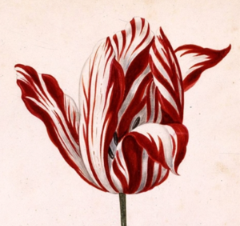Items
Site
The Medicine Chest
keywords is exactly
suppression
-

The broken tulip
"During the period known as tulipmania which transpired in the Netherlands during the 17th century, contract prices for bulbs of the recently introduced tulip reached extraordinarily high levels and then suddenly collapsed. Tulips that displayed a break in their colour reached prices far higher than those that didn’t. It wasn’t until 1920, after the invention of the electron microscope, that scientists discovered that the cause for this symphony of colour was a virus that spread from tulip to tulip by Myzus persicae, the peach potato aphid. Michael Pollan in The Botany of Desire, explains this phenomenon: “The colour of a tulip consists of two pigments working in concert — a base colour that is always yellow or white and a second, laid-on colour called an anthocyanin; the mix of these two hues determining the unitary colour we see. The virus works by partially and irregularly suppressing the anthocyanin, thereby allowing a portion of the underlying colour to show through — creating the magic of the broken tulip. A fact that, as soon as it was discovered, doomed the beauty it had made possible" (Pollan 2003: 97 in Liebenberg 2011: 92). -

Semper Augustus Tulip
Photo of Semper Augustus watercolour, captured whilst perusing the Pera Museum, Istanbul, 2013


